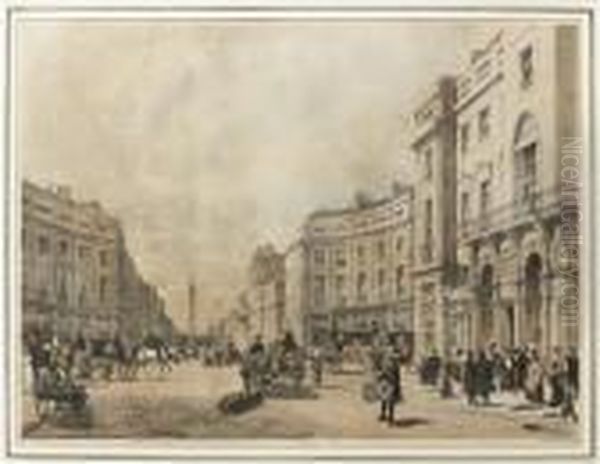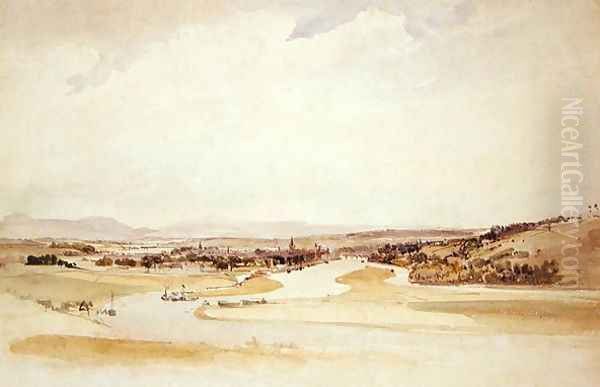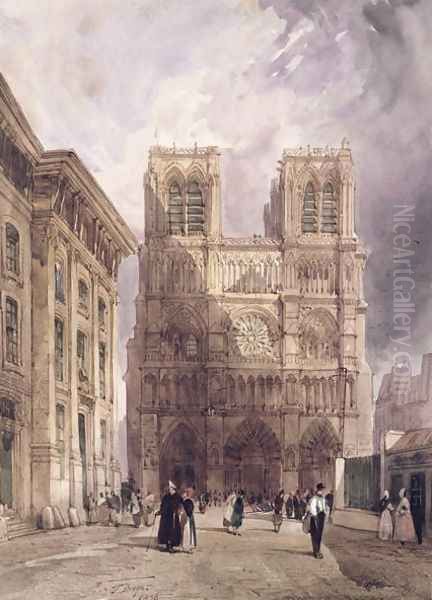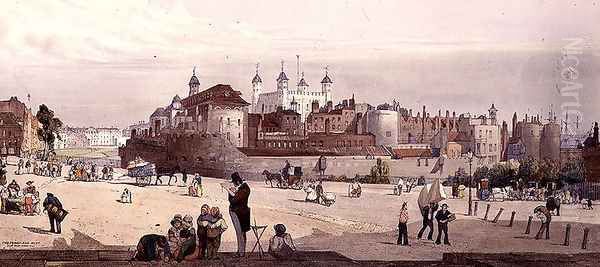Thomas Shotter Boys stands as a significant figure in 19th-century British art, celebrated primarily for his exquisite watercolours and his groundbreaking work in the field of printmaking, particularly chromolithography. Born in Pentonville, London, in 1803, Boys navigated the vibrant, shifting art scenes of both London and Paris, leaving behind a legacy defined by technical innovation and a sensitive eye for architectural beauty. His career bridges the gap between the topographical tradition and the burgeoning Romantic sensibility, capturing the essence of European cities with remarkable precision and atmospheric charm. He was not merely a recorder of buildings, but an artist who understood how light, shadow, and human activity brought urban landscapes to life.
Early Life and Artistic Formation
Thomas Shotter Boys' journey into the art world began not with a paintbrush, but with an engraver's burin. He was apprenticed to George Cooke, a respected engraver known for his reproductive work, particularly after the paintings of J.M.W. Turner. This early training instilled in Boys a meticulous attention to detail and a strong command of line, qualities that would underpin his later work in both watercolour and lithography. While engraving provided a solid technical foundation, Boys's artistic aspirations soon expanded beyond the confines of reproductive printmaking.
The pivotal moment in his early career came through his encounter with the burgeoning Romantic movement and, more specifically, the work and person of Richard Parkes Bonington. Bonington, a brilliant Anglo-French artist whose star shone brightly but briefly, became a profound influence and a close friend. It was under Bonington's sway that Boys began to seriously pursue watercolour painting, drawn to its immediacy and potential for capturing atmospheric effects – a stark contrast to the laborious process of line engraving he had learned under Cooke.
The Parisian Years and the Influence of Bonington

Around the mid-1820s, Boys relocated to Paris, a city that was then a crucible of artistic innovation and debate, particularly between the Neoclassical and Romantic schools. Here, his connection with Richard Parkes Bonington deepened. Paris provided a stimulating environment, rich with architectural subjects and a lively community of artists. Boys became one of Bonington's closest English associates in the city, absorbing his friend's fluid watercolour technique, his interest in historical and architectural subjects, and his sophisticated use of light and colour.
Bonington, alongside artists like Eugène Delacroix, was exploring the possibilities of lithography, a relatively new printmaking technique invented by Alois Senefelder. Bonington encouraged Boys to explore this medium and likely taught him the basics of lithography and etching. Boys proved an adept pupil, quickly mastering these techniques. He even produced lithographs after some of Bonington's works, demonstrating his skill in translating the painterly qualities of his friend's art into print. The tragically early death of Bonington in 1828 was a significant blow, but his influence on Boys's artistic direction was indelible.
Mastery of Watercolour
While increasingly involved in printmaking, Boys continued to develop his skills as a watercolourist. His style, though clearly indebted to Bonington's fluid handling and atmospheric sensitivity, evolved its own distinct character. Boys possessed a remarkable ability to render complex architectural details with accuracy without sacrificing the overall mood or sense of place. His watercolours often depict bustling street scenes, tranquil canals, or majestic cathedrals, primarily drawn from his travels in France, Belgium, and later, London.
His technique involved transparent washes, often layered to build depth and luminosity, combined with precise drawing that defined architectural forms. He sometimes incorporated bodycolour (gouache) for highlights or to add opacity, a practice common among watercolourists of the period like Samuel Prout, another master of the architectural view. Unlike the dramatic, often sublime landscapes of J.M.W. Turner or the rustic charm found in the works of David Cox or Peter De Wint, Boys focused on the urban environment, capturing its specific character through careful observation and a subtly romanticised lens. His compositions are typically well-structured, guiding the viewer's eye through the scene with a clear sense of perspective and spatial depth.
Pioneering Chromolithography: Picturesque Architecture

Thomas Shotter Boys secured his place in art history with the publication of Picturesque Architecture in Paris, Ghent, Antwerp, Rouen, etc. in 1839. This volume was a landmark achievement, representing one of the very first successful attempts to print a book entirely illustrated using chromolithography – the process of printing lithographs in multiple colours. While experiments in colour lithography had been undertaken by others, notably Godefroy Engelmann in France, Boys's publication, printed by the influential Charles Hullmandel in London, was groundbreaking in its ambition and quality.
Chromolithography involved drawing the image separately onto multiple lithographic stones, one for each colour to be printed. These stones were then inked with the appropriate colour and printed sequentially onto the same sheet of paper, requiring precise registration to ensure the colours aligned correctly. Boys's plates for Picturesque Architecture typically used several tint stones (usually buffs, greys, blues) in addition to the black key stone which carried the main drawing. This allowed for subtle tonal variations and a convincing representation of light and atmosphere, far surpassing hand-colouring in consistency and artistic control. The publication showcased Boys's superb draughtsmanship and his ability to translate the nuances of his watercolours into this complex new print medium. It was lauded for its technical brilliance and artistic merit.
Original Views of London as It Is
Following the success of his continental views, Boys turned his attention to his native city. In 1842, he published Original Views of London as It Is, another significant series of tinted lithographs printed by Charles Hullmandel. This collection presented a panorama of early Victorian London, capturing iconic landmarks like St. Paul's Cathedral, Westminster Abbey, and Buckingham Palace, alongside bustling street scenes, bridges, and squares. The plates continued to demonstrate Boys's mastery of architectural rendering and atmospheric effect.
These London views combined topographical accuracy with a picturesque sensibility. He depicted the grandeur of the city's architecture but also included details of daily life – carriages, pedestrians, street vendors – which animated the scenes. The quality of the lithographs was exceptional, showcasing the potential of the medium for large-scale topographical projects. The series was highly regarded and even earned Boys recognition from the French King, Louis-Philippe, who awarded him a medal for his artistic achievements, a testament to his international reputation. These works stand alongside those of other recorders of London, like the earlier Canaletto or later artists, but possess Boys's unique blend of precision and romantic feeling.
Other Works and Collaborations

Beyond his two major lithographic publications, Boys remained active as a watercolourist and printmaker. He exhibited his watercolours regularly, primarily at the New Society of Painters in Water Colours, of which he became a member in 1841. His subjects continued to be predominantly architectural views drawn from his travels in Britain and the Continent. He also undertook illustrative work, contributing drawings for publications such as Blackie's History of England.
His skills in etching, likely honed during his time with Bonington, were also employed in collaboration with the influential art critic and writer John Ruskin. Boys is known to have etched some plates for Ruskin, demonstrating his versatility across different printmaking techniques. He also maintained connections with fellow artists. William Callow, another prominent watercolourist known for his continental scenes, shared a studio with Boys for a period in Paris and acknowledged learning much from him about watercolour technique and architectural drawing. Boys also collaborated with members of the Fielding family of artists, notably Copley Fielding, who were significant figures in the watercolour society.
Artistic Style and Technique Summarized
Thomas Shotter Boys's artistic signature lies in the fusion of meticulous accuracy with a gentle Romanticism. His training as an engraver provided the discipline for precise architectural delineation, evident in both his watercolours and prints. Yet, influenced by Bonington and the broader Romantic movement, he imbued his scenes with atmosphere, paying close attention to the play of light and shadow, weather conditions, and the textures of stone and sky. He avoided the dramatic intensity of Turner or the ruggedness of Cox, favouring instead a clarity and elegance in his compositions.
In watercolour, he employed controlled washes and fine brushwork, often building up layers to achieve depth and luminosity. His lithographs, particularly the chromolithographs, translated these qualities effectively. The use of multiple tint stones allowed for subtle gradations of tone and colour, mimicking the effects of watercolour washes while retaining the clarity of the drawn line from the key stone. His compositions are typically balanced and well-structured, often employing strong diagonals or framing devices to lead the eye into the scene, creating a convincing sense of three-dimensional space. He captured not just the look of a building, but its presence within the urban fabric.
Contemporaries and Context

Boys operated within a rich artistic milieu in both Britain and France during a period of significant change. In Britain, watercolour painting was reaching a peak of popularity and sophistication, with artists like J.M.W. Turner, David Cox, Peter De Wint, Copley Fielding, and Samuel Prout dominating the scene. Boys carved his niche within this group, specializing in detailed architectural views, a field where Prout was also highly regarded, though Boys often brought a lighter, more Bonington-esque touch compared to Prout's sometimes heavier style. David Roberts was another contemporary known for grand architectural and topographical views, often from more exotic locales.
In Paris, Boys was part of the circle around Bonington, which included French artists like Eugène Delacroix and possibly Eugène Isabey and Camille Roqueplan, all exploring Romantic themes and experimenting with lithography. His move back to London coincided with the rise of lithography as a major reproductive and artistic medium, largely driven by printers like Charles Hullmandel. Boys's work in chromolithography placed him at the forefront of print technology. He navigated the transition from the late Georgian era's topographical traditions, influenced by figures like Paul Sandby, towards the more atmospheric and personalized approach of the Victorian period.
Later Life and Legacy
Despite the success of his major publications and his election to the New Society of Painters in Water Colours, Thomas Shotter Boys's later career was marked by difficulties. He suffered from recurring ill health, which hampered his productivity. Financial struggles also plagued him in his later years, a common fate for many artists of the period who relied on sales and commissions. He continued to work, but perhaps without the same level of visibility or innovation as in his earlier decades. He passed away in London in 1874.
Nevertheless, Boys's legacy is secure. His primary contribution lies in his pioneering work with chromolithography. Picturesque Architecture remains a milestone in the history of colour printing and book illustration. His watercolours and lithographs are admired for their technical skill, their faithful yet artistic rendering of architectural subjects, and their evocative capture of 19th-century urban life. His work influenced subsequent architectural illustrators and watercolourists. Today, his works are held in major museum collections worldwide, including the British Museum, the Victoria and Albert Museum in London, the Louvre and Bibliothèque Nationale in Paris, and numerous institutions in the United States, ensuring his contribution to British art and printmaking history is remembered and studied.
Conclusion
Thomas Shotter Boys was more than just a skilled topographical artist. He was an innovator who embraced and advanced the new technology of chromolithography, creating works of lasting beauty and historical significance. His ability to combine the engraver's precision with the painter's sensitivity to light and atmosphere allowed him to capture the essence of European cities during a period of transformation. Influenced by the Romanticism of Bonington yet retaining his own distinct style, Boys produced a body of work that continues to delight viewers with its detail, charm, and technical brilliance. He remains a key figure in the story of British watercolour and a pivotal pioneer in the history of colour printmaking.